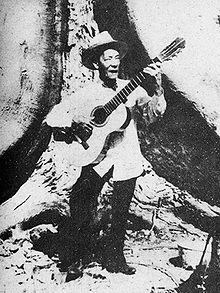SINDO GARAY, CONOCIDO COMO “EL GRAN FARAÓN” DE LA MÚSICA CUBANA. FOTOS. VIDEOS.
Gumersindo Antonio Garay y García, conocido como Sindo Garay fue un músico de trova cubano. Garay fue uno de sus llamados cuatro grandes de la trova Cubana. Fue enseñado por Pepe Sánchez, el creador del ritmo Bolero.
Aún sin una formación formal, supo conquistar un destacado lugar en la trova tradicional. Sindo Garay, uno de los trovadores de primer nivel de la música popular cubana, fue un verdadero genio. Fue creador de más de 600 obras que retratan la idiosincrasia cubana; entre sus destaca su admiración por su tierra natal, los paisajes, las mujeres y el amor.
Antonio Garay Gumersindo García fue bautizado por el poeta español Federico García Lorca como “El Gran Faraón de Cuba”.
Garay fue el más destacado compositor de canciones de trova, y sus mejores canciones han sido cantadas y grabadas muchas veces. Perla marina, Adios a La Habana, Mujer bayamesa, El huracan y la palma, Guarina y tantas otras forman ya parte del patrimonio de Cuba. Garay también era analfabeto musical -de hecho, solo aprendió el abecedario a los 16 años-, pero en su caso no solo fueron transcritas partituras por otros, sino que también hay grabaciones.
Sindo Garay nació en Santiago de Cuba el 12 de abril de 1867. Fue el primero, el más pequeño y quizás el más longevo de los trovadores, descendiente de españoles y arahuacos. Era indocubano.
VIDEOS- VIDA DE SINDO GARAY CANTADA…
En su infancia, en pleno apogeo de la primera guerra contra el colonialismo español, más de una vez llevó importantes mensajes de los patriotas cubanos. La célebre historia de un adolescente que atravesó repetidamente la bahía de Santiago de Cuba, una de las mayores del país, con órdenes laborantes y documentos cubanos contra España. En ese momento, Pepe Sánchez (el creador del bolero) era uno en la casa de Garay, ya través de él se enviaban los mensajes para preparar la guerra mambisa. “Pepe fue un gran cantor y la canción cubanizó. Tiene que aparecer como un precursor de la trova cubana. Fue el único maestro que tuve en mi vida. Me dice: ¡Sindo Garay!”. Pero también a Sindo se le dio el privilegio de conocer a Martí.
Ignorante de las nociones más elementales de las técnicas formales creó la música, sin embargo, consideró perfectas las obras musicales. El bolero oriental en sindo tuvo su mejor momento, pues impuso su peculiar estilo raspando las cuerdas de la guitarra para cerrar las frases musicales y el compás con el llamado cinquillo cubano.
Como la mayoría de los campesinos de la trova, Sindo también trabajaba y hacía el canto con libertad rítmica, pero se le atribuye alguna que otra criolla, guaracha, alguna influida por la obra bambuco colombiana, y cuando hablaba de su peculiar estilo me refería precisamente a su manera original de manejar estos formularios.
El título de Bayamesa, muy utilizado por diversos autores cubanos en innumerables obras, es quizás su canción más conocida.
Sindo cuenta que después de una noche de serenata, despertó en casa de un amigo, en cuyo patio había un muro aún ennegrecido por el fuego de Bayamo, y allí le asaltó la inspiración en un simple cartucho de papel que anotó sus versos de obra inmortal. Guitarra por la melodía vienen después. Paradójicamente, el estreno de esta canción fue para el taquillero y pianista de cine bayamés, único público de aquella noche.
En julio de 1968, exactamente el día 17, moría a la edad de 101 años el más grande cantor de esta tierra de juglares. El festival de la trova de ese año estuvo dedicado a su memoria y su Bayamesa resonó repetidamente en las voces de muchos cantantes diferentes. En su impresionante entierro ya encendió puros y cigarrillos por lo que Sindo había pedido.
Sindo Garay fue un genio popular, y lo más asombroso es que toda la música cubana rezuma aprendida en su vida laboral, dibujada en su cabeza, su garganta y sus manos en la guitarra. Para él un papel musical con notas musicales no tenía significado como un misterioso jeroglífico indescifrable. Sólo desde su excesiva sensibilidad y capacidad para sintetizar y reformular hechos sonoros, pudo, desde su falta de técnica musical formal, realizar las obras que realizó.
El Juglar, le estuvo cantando a su patria durante 89 años, tiene cada 17 de julio congregación de trovadores y amigos sobrios al cementerio de la necrópolis de Bayamo. Dejamos sobre la losa flores nuevas, y en el aire, las notas del canto que inmortalizó a esa ciudad, su tierra, su gente, a su obra.
SINDO GARAY, KNOWN AS “THE GREAT PHARAOH” OF THE CUBAN MUSIC. PHOTOS.
Gumersindo Antonio Garay and Garcia, known as Sindo Garay was a Cuban trova musician. He was taught by Pepe Sánchez, the creator of the rhythm Bolero. Garay was one of the four greats of the trova.
Even without formal training, was able to win an outstanding place in the traditional trova. Sindo Garay, one of the top rankings troubadours of Cuban music, popular was a true genius. He was the creator of more than 600 works that portray the Cuban idiosyncrasy; among his highlights his admiration for his homeland, landscapes, women and love.
Antonio Garay Gumersindo Garcia was baptized by Spanish Poet Federico Garcia Lorca as “The Great Pharaoh of Cuba”.
Garay was the most outstanding composer of trova songs, and his best have been sung and recorded many times. Perla marina, Adios a La Habana, Mujer bayamesa, El huracan y la palma, Guarina and many others are now part of Cuba’s heritage. Garay was also musically illiterate – in fact, he only taught himself the alphabet at 16 – but in his case not only were scores transcribed by others, but there are recordings as well.
Sindo Garay was born in Santiago de Cuba on April 12, 1867. He was the first, the smallest, and perhaps the longest-lived, of the trova artists, he was Spanish & Arawakan descendant. He was Indo-Cuban.
In his childhood, at the height of the first war against Spanish colonialism, more than once carried important messages of the Cuban patriots. The famous story of a teenager being repeatedly crossed the Bay of Santiago de Cuba, one of the largest in the country, with orders and documents laborantes Cubans against Spain. At that time, Pepe Sanchez (the creator of the bolero) was one in the house of Garay, and through him the messages were sent to prepare mambisa war. “Pepe was a great singer and the song Cubanized. Has to appear as a precursor of the Cuban trova. He was the only teacher I had in my life. Says me: Sindo Garay!” But also Sindo was given the privilege of meeting Martí.
Ignorant of the most elementary notions of formal techniques created the music, however, considered musical works perfect. The Eastern bolero in Sindo had its finest, as it imposed its peculiar style scratching the guitar strings to close the musical phrases and the rhythm with the so-called Cuban cinquillo.
Like most farmers of the trova, Sindo also worked and did the song with rhythmic freedom, but is credited with the occasional Creole, guaracha, some influenced by the work bambuco Colombian, and when he spoke of his peculiar style, I meant precisely to its original way of handling these forms.
The Bayamesa title widely used by various authors Cubans in countless works, is perhaps their best known song.
Sindo account that after a night of serenading, waking at a friend’s house, in whose court was a wall still blackened by the fire of Bayamo, and inspiration struck him there in a simple paper cartridge scored his verses immortal work. Guitar by the melody come later. Paradoxically, the release of this song was for the blockbuster and movie theater pianist Bayamo, unique audience that night.
In July 1968, exactly on the 17th, died at the age of 101 years the greatest singer of this land of minstrels. The trova festival that year was dedicated to his memory and his Bayamesa repeatedly echoed in the voices of many different singers. In his impressive funeral and lit cigars and cigarettes for so had asked Sindo.
Sindo Garay was a popular genius, and the most amazing thing is that all Cuban music oozing learned in his work life, drew in his head, his throat and his hands on the guitar. To him a music paper with musical notes had no meaning as a mysterious hieroglyphics undecipherable. Only from its excessive sensitivity and ability to synthesize and restate facts sound, could, from his lack of formal musical technique, do the works he did.
The Juglar, he was singing to his homeland for 89 years, has every July 17th congregation of troubadours and sober friends to the cemetery in the necropolis of Bayamo. We left on the slab new flowers, and in the air, the notes of the song that immortalized to that city, his land, his people, to his work.
Agencies/ Wiki/ EcuRed/ SindoGarayBio./ Extractos/ Excerpts/ Internet Photos/ YouTube/ Arnoldo Varona/ www.TheCubanHistory.com
THE CUBAN HISTORY, HOLLYWOOD.










